Potatoes are the ultimate grow-your-own crop. They’re easy to plant, a joy to harvest, and oh-so-satisfying to eat.
Whether you’re making creamy mashed potatoes or crispy fries, the taste of homegrown potatoes is unbeatable. Plus, they’re pretty low maintenance, making them perfect for gardeners of all levels.
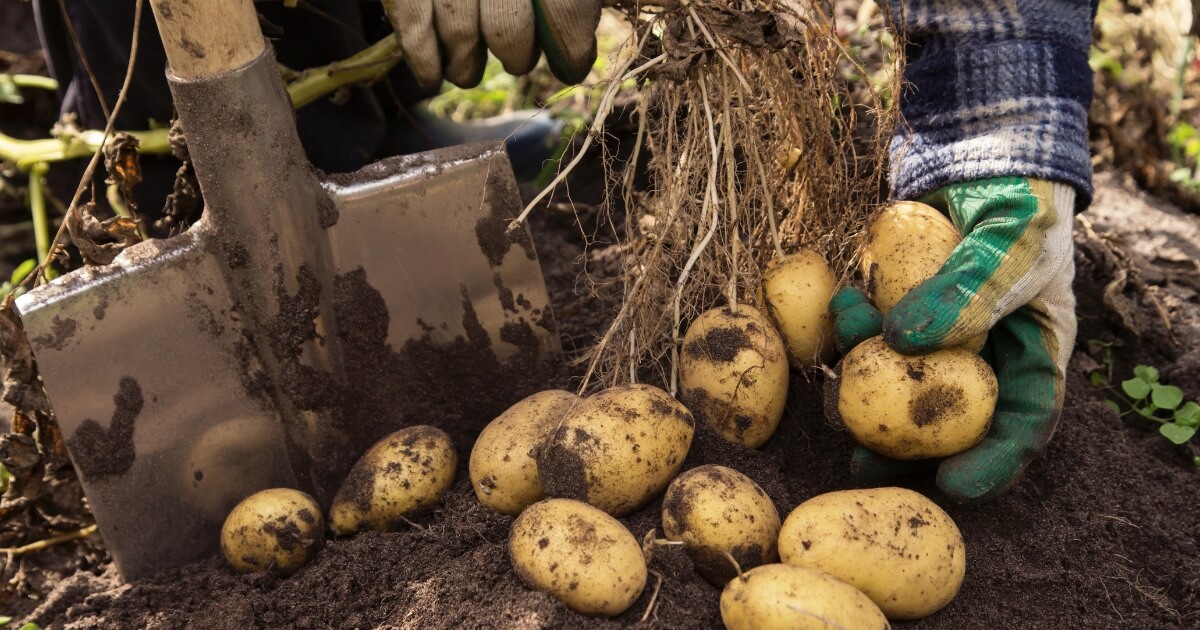
Growing Difficulty
2 (Easy)
Days To Harvest
70-120 days
Sunlight
Full sun, 6+ hours
Watering
Weekly
Soil Type
Well-drained, loamy
Seed Spacing
2
Planting Depth
3″
Temperature
2
I’ve found that if you give them the basics, such as decent soil, enough sunlight, and proper watering, they’re likely to reward you with a bountiful harvest. It’s like they understand that we might not get everything perfect, and they’re cool with it.
Potato Growing Overview
For beginners, growing potatoes offers quick gratification with minimal fuss. And if you run into hiccups along the way, potatoes are resilient enough to bounce back with some care.
Intermediate gardeners can experiment with different varieties or try more advanced techniques like growing in containers or implementing companion planting to boost their crop’s health and yield.
Key Growing Factors:
- Sunlight: Potatoes love their sunshine. Make sure they get at least 6 hours of direct light each day.
- Spacing: Give each plant about 12 inches of space. This allows for growth underground, where the magic happens.
- Hilling: You should pile soil around the stems as they grow to encourage more spuds.
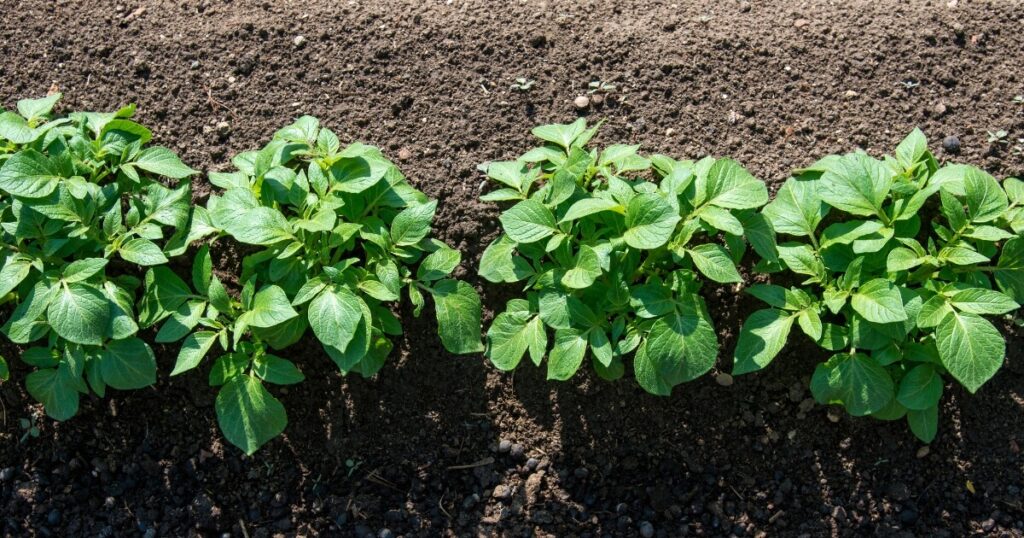
Tolerance to Environmental Conditions: Potatoes are adaptable and can tolerate a range of conditions, but extreme temperatures can cause problems. They prefer it not to be too hot or too cold. The best temperature zone for potatoes is between 45°F and 80°F.
Pest and Disease Resistance: Watch out for potato beetles! These little critters have a taste for your taters. Rot can also be an issue in overly wet conditions. Rotate your crops yearly to prevent disease buildup in the soil. (What to plant after potatoes)
Watering Requirements: Your soil should be moist but not waterlogged. Watering deeply once a week should do the trick, depending on rainfall and temperature.
Soil Preferences: Potatoes aren’t picky but thrive in well-drained, loamy soil. Amend heavy clay soils or consider raised beds if drainage is an issue.
Location & Soil Preparation
Key Points:
- Sunlight: Full sun location (6+ hours daily).
- Drainage: Choose or create well-drained sites.
- Soil Type: Loamy, slightly acidic (pH 5.0-6.0), and fertile.
- Soil Prep: Amend with compost or aged manure before planting.
When picking a spot to plant your potatoes, aim for a location that gets full sun. Potatoes are like sunbathers—they soak up those rays to produce the energy they need for growing those delicious tubers.
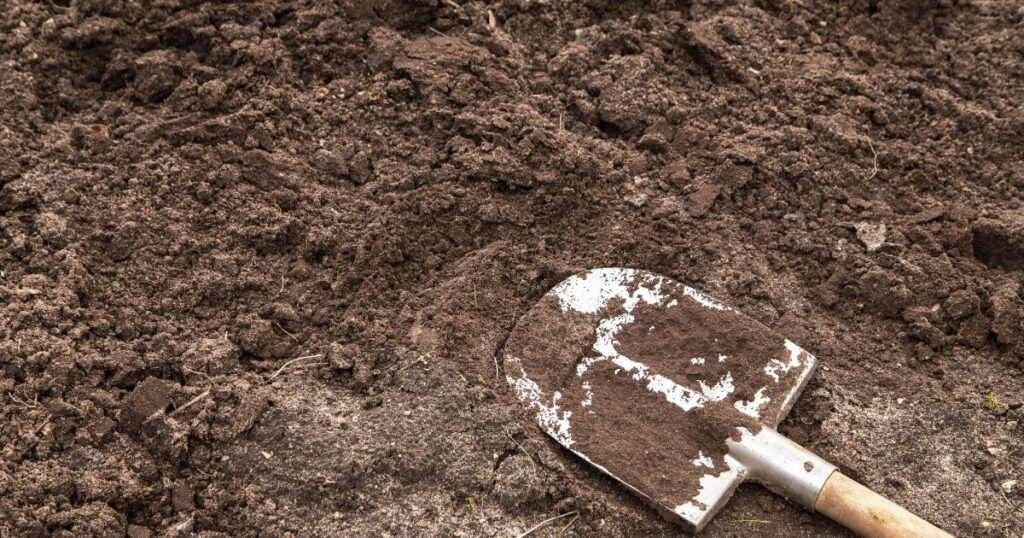
The ideal spot is one where your plants will bask in at least 6 hours of sunlight daily.
Drainage is another big deal for potatoes. A well-drained location is required to prevent rot, which is caused by water pooling around their roots.
If you’re dealing with heavy clay soil that retains water like a sponge, you can improve drainage by mixing in some compost or sand or farm them in a raised bed.
Potatoes prefer loamy soil that’s loose and fertile. If you have time before planting, work in some aged manure or compost to give them a nutrient boost. And remember, pH matters, too. They do best in slightly acidic soil with a pH of about 5.0-6.0.
Planting
Special Considerations:
- Seed Potatoes: Use certified seed potatoes to reduce disease risk.
- Cutting Pieces: If your seed potatoes are large, cut them into pieces with at least one or two eyes per piece.
- Curing: Let cut pieces sit at room temperature for a couple of days to form a protective callus over the cuts.
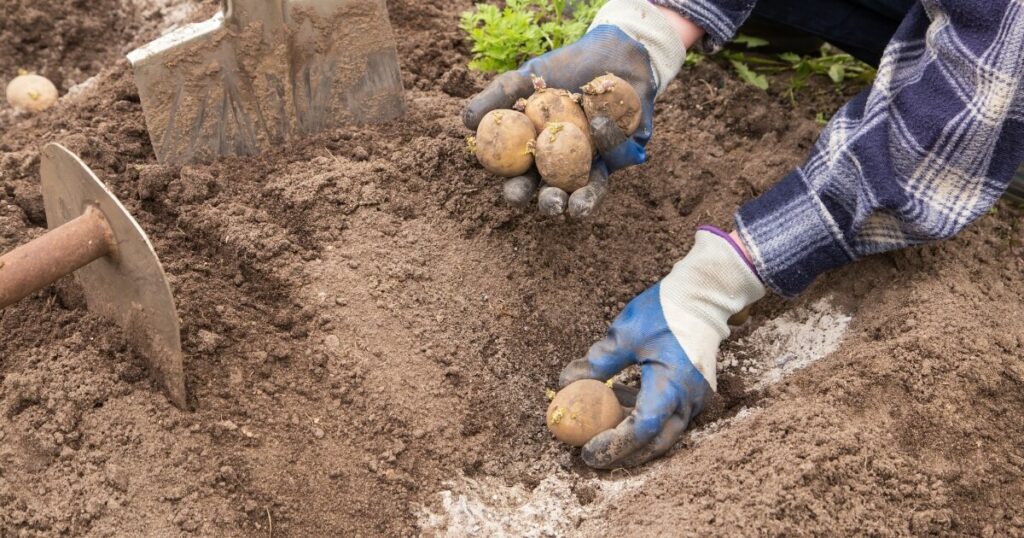
When it comes to planting potatoes, you should aim for early spring once the danger of frost has passed and your soil can be worked.
To be safe, you can plant as soon as your soil temperature reaches 45°F. But, if you’re eager like me, you can try planting two weeks before the last expected frost date since many types of potatoes can handle a light frost.
For spacing, potatoes don’t like to be crowded. Plant seed potatoes about 3 inches deep and give them about 12 inches apart in rows. Rows spaced about 3 feet apart gives you room to walk and hill the plants later on.
Caring For Your Potato Plants
Key Points:
- Watering: Consistent moisture is key, especially during tuber formation.
- Fertilizing: Use a balanced fertilizer for bigger potatoes during planting and again midseason.
- Hilling: Regularly pile soil around the plants as they grow.
- Mulching: Helps retain moisture and control weeds.
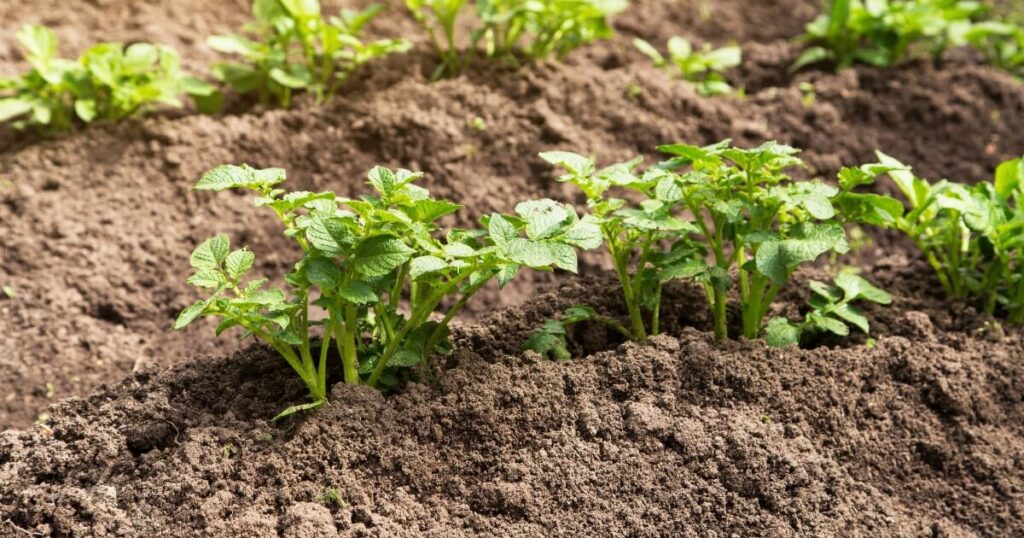
Potatoes aren’t high maintenance, but they do need consistent moisture. This is especially true during the period when they’re forming tubers. About 1 to 2 inches of water per week from rainfall or supplemental watering is ideal.
Avoid overhead watering to help reduce the risk of disease, and try to keep the water level steady because potatoes aren’t fans of a feast-or-famine approach.
Fertilizing your potatoes encourages them to grow strong and produce well, but it is not required if you’re planting in fertile soil. Compost and manure are excellent options to mix in before planting.
Otherwise, you can start with a balanced 10-10-10 fertilizer when you plant them. Then, give them another dose of encouragement (fertilizer) about halfway through the growing season. This midseason boost helps them finish strong.
Special considerations for potatoes include hilling and mulching.
Hilling potatoes means piling soil around the stems as they grow. This protects developing tubers from sunlight, which can turn them green. Mulch with straw or leaves to retain soil moisture and suppress weeds without competing with your spuds for nutrients.
Pest & Disease Management
Staying vigilant against pests and potato diseases is key to keeping your plants healthy. Here’s a rundown of common issues you might encounter and how to tackle them.
Common Potato Pests:
- Colorado Potato Beetle: These striped munchers can decimate foliage. Handpick beetles and larvae or use floating row covers for protection.
- Aphids: Tiny pests that suck plant juices, potentially spreading disease. Beneficial insects like ladybugs can help reduce aphid populations in your garden, and insecticide should only be used as a last resort.
- Wireworms: The larvae of click beetles burrow into potatoes, causing damage. Rotate crops and use pheromone traps to monitor their presence.
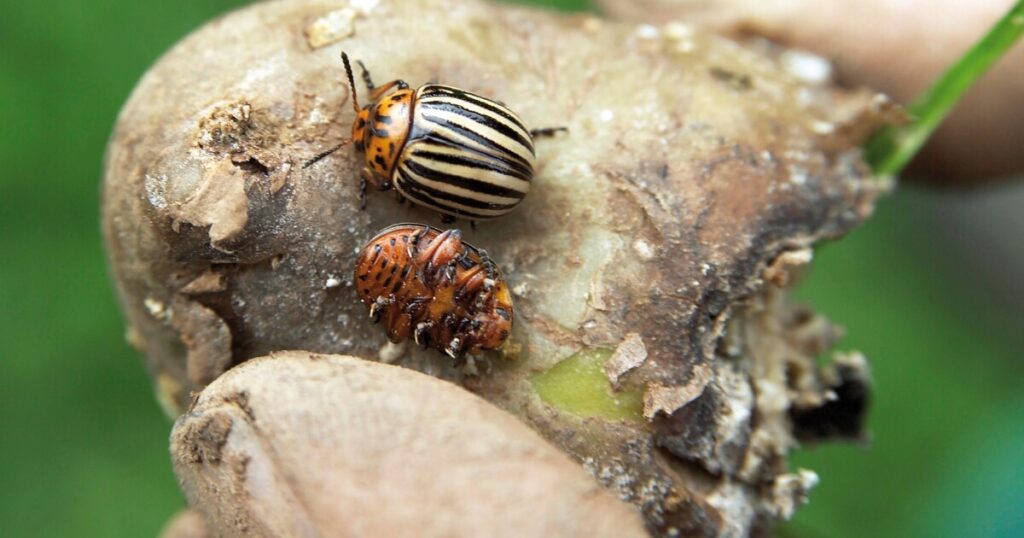
Frequent Potato Diseases:
- Late Blight: A serious fungal infection that causes dark spots on leaves and tubers. Your best defense is blight-resistant potatoes, keeping good air circulation, and practicing crop rotation.
- Early Blight: You’ll see patches with concentric rings on leaves that lead to reduced yields or premature plant death. Remove affected foliage and apply fungicides if necessary.
- Scab: Causes rough patches on potato skins but doesn’t affect the inside. Maintain proper pH levels in your soil and avoid adding too much lime.
Harvesting & Storage
When your potato plants start to yellow and wilt, it’s a sign that harvest time is near. This typically happens about 2 to 3 weeks after the plants have finished flowering.

For new potatoes, which are tender and small, gently dig around the base of your plants with your hands a few weeks after flowering to check them.
But if you’re after larger spuds for storage, wait until the plant tops die back.
Harvesting Instructions:
- Check for Readiness: Potatoes are usually ready when their foliage yellows and dies back.
- Dig Carefully: Use a spade or fork to loosen the soil around your plants, and lift potatoes gently to avoid bruising. Be careful not to cut into your potatoes.
- Cure Potatoes: Let them dry on the soil surface for a few hours if the weather is dry to toughen up their skin.
Once harvested, proper storage is essential to keep your potatoes fresh for months.
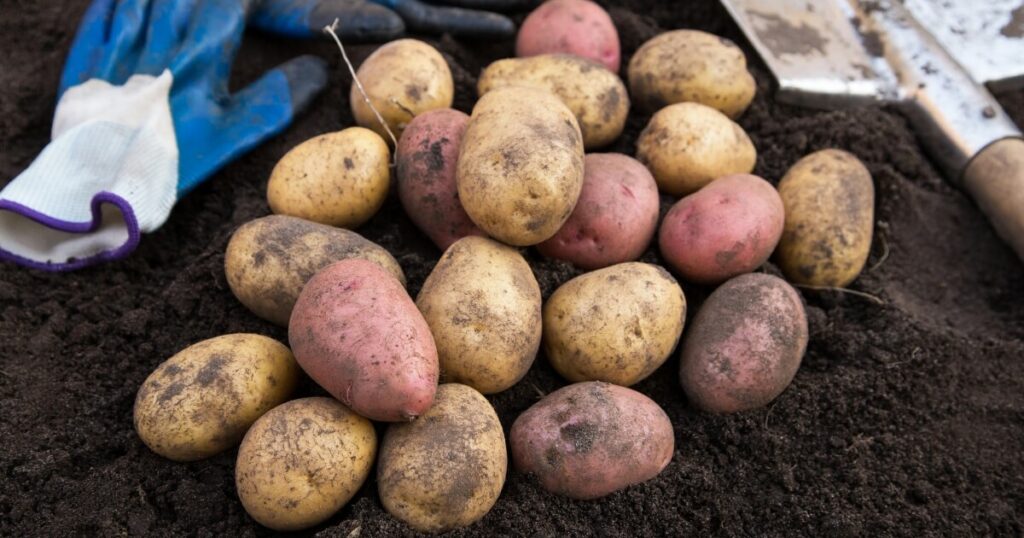
Storage Instructions:
- Cure Before Storing: After harvesting, cure potatoes in a dark place with good ventilation for about two weeks.
- Ideal Conditions: Store in a cool (about 45°F), dark, and humid environment to prevent shriveling.
- Check Regularly: Inspect your stored potatoes often. You should remove any that show signs of rot or sprouting.
Frequently Asked Questions
Can I Plant Potatoes From The Grocery Store?
While you can plant grocery-store potatoes, I don’t recommend them as they may carry diseases or other problems that can transfer to your garden. Certified seed potatoes are a safer bet for a healthy crop.
How Many Potatoes Will One Plant Produce?
Depending on the variety and growing conditions, a single potato plant can yield up to 10 potatoes. I often get 4-7 good-sized potatoes and a few smaller ones per plant.
Do I Need To Chit My Seed Potatoes Before Planting?
Chitting, or pre-sprouting, your seed potatoes can lead to a faster start and potentially earlier harvest, but it isn’t necessary. It’s more of a personal preference.




